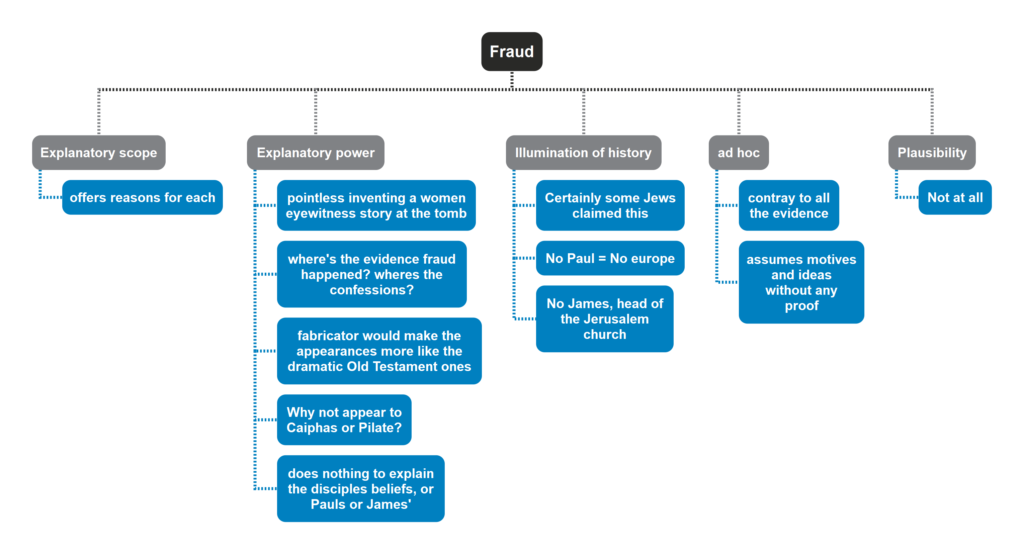7.2 Evaluating the Fraud/conspiracy theory

Explanatory scope
This theory meets the condition pretty well, it offers explanations of the empty tomb (the disciples stole the body), the postmortem appearances (the disciples lied about these), and the origin of the disciples’ (supposed) belief in Jesus’ resurrection (again, they lied).
Explanatory power
Here doubts begin to arise. Take the empty tomb, for example, if the disciples stole Jesus’ corpse, then it would be utterly pointless to fabricate a story about women finding the tomb to be empty. Such a story would not be the sort of tale Jewish men would create. Moreover, the simplicity of the story is not well explained by this theory—where are the scriptural proof texts, the evidence of fulfilled prophecy? Why isn’t Jesus described as emerging from the tomb extremely dramatically, as in later forgeries like the Gospel of Peter? Neither is the dispute with non-believing Jews well explained.
As for the appearance stories, similar problems arise. A fabricator would probably describe Jesus’ resurrection appearances in terms of Old Testament visions of God and descriptions of the end-time resurrection (as in Daniel 12:2). But then Jesus should appear to the disciples in blazing glory. And why not a description of the resurrection itself? Why no appearances to Caiaphas the high priest or to the villains on the Sanhedrin, as Jesus predicted? They could be then branded as the real liars for denying that Jesus did appear to them!
But the explanatory power of this theory is undoubtedly weakest when it comes to the origin of the disciples’ belief in Jesus’ resurrection. For the theory is really a denial of that fact; it seeks to explain the mere semblance of belief on the disciples’ part. But as critics have universally recognized, you can’t plausibly deny that the earliest disciples at least sincerely believed that Jesus was risen from the dead. They pinned their very lives on that conviction. The transformation in the lives of the disciples is not explained by the theory of a conspiracy. This shortcoming alone has been enough in the minds of most scholars to sink the old conspiracy theory forever.
Illumination of history
Certainly by stealing the body we do have an empty tomb, but explaining the origins of the Christian beliefs is where this theory again falls into problems. Paul, an important author in the Christian tradition would not have been convinced by an empty tomb, nor James, the head of the Jerusalem church. Without these two figures, the church would not have a strong head in Jerusalem perhaps, and without Paul’s missionary journey to the gentiles, how would Christianity ever get out of the middle east? Nevermind at such speed. The Conspiracy theory does a bad job at attaining for historical facts such as the origins of Christianity and the works of Paul’s evangelism.
Less ad hoc
Like all conspiracy theories of history, this theory is ad hoc in supposing that what all the evidence seems to point to is, in fact, mere appearance only, to be explained away by theory for which there is no evidence. Specifically, it assumes motives and ideas in the minds of the earliest disciples and actions on their part for which there is not a shred of evidence for.
It can become even more ad hoc, as a theory has to be multiplied to deal with objections to the theory; for example, how to account for the women’s role in the empty tomb and appearance stories.
Plausibility
The theory tends to be disconfirmed by our general knowledge of conspiracies, their instability and tendency to unravel. Moreover, it is disconfirmed by accepted beliefs such as the sincerity of the disciples, the nature of first-century Jewish messianic expectations, and so on. The conspiracy theory obviously fails this condition, since there are better theory (such as the hallucination theory), which don’t dismiss the disciples’ belief in Jesus’ resurrection as a blatant lie. No scholar would defend the conspiracy theory today. The only place you read about such things is in the popular, sensationalist press or Internet fantasies.




0 Comments